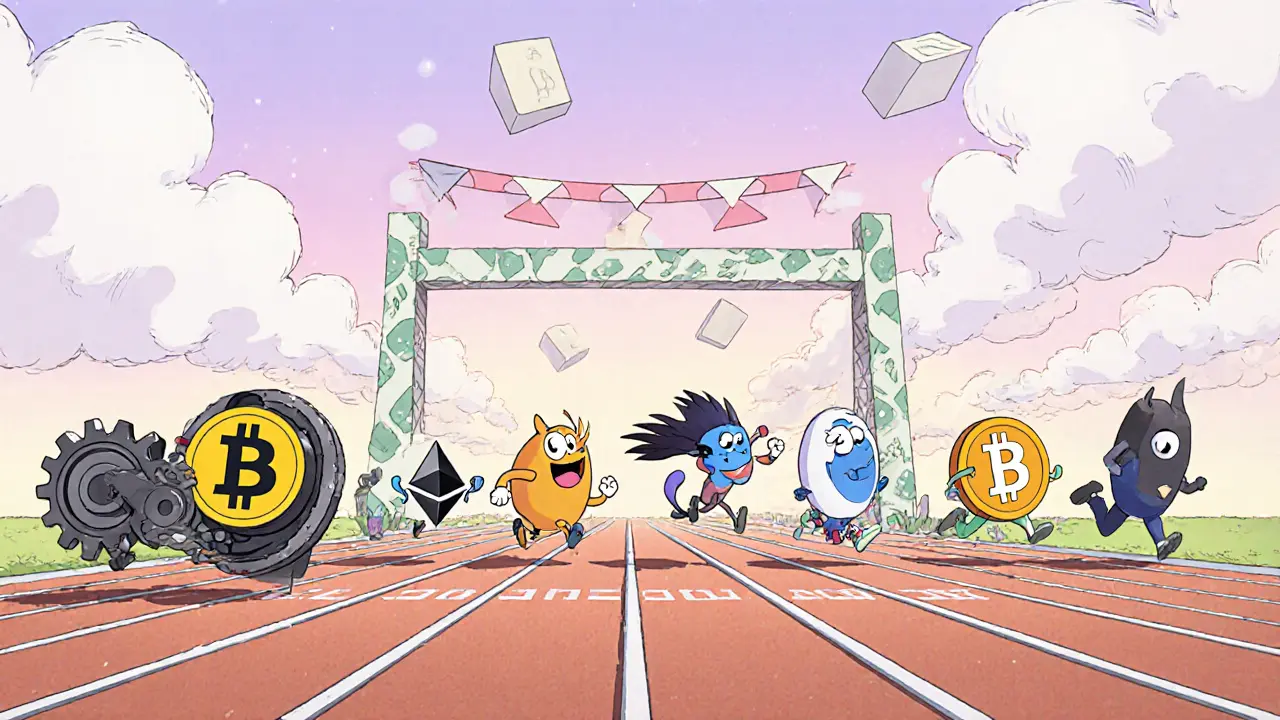Crypto Confirmation Time Calculator
Estimate Your Transaction Confirmation Time
Enter your transaction details to see expected confirmation times, recommended confirmations, and security level.
Expected Confirmation Time
Recommended Confirmations
Security Assessment
Additional Recommendations
Ever sent a crypto payment and wondered why it sometimes lands instantly while other times it lingers for hours? The secret lies in cryptocurrency confirmation time is the period between broadcasting a transaction to the network and seeing it embedded in a confirmed block. Understanding this metric helps you set realistic expectations, choose the right fee, and avoid costly double‑spend attacks.
What "confirmation time" Actually Means
In plain terms, a confirmation is a stamp of approval from the blockchain. When a miner bundles your transaction into a block, the network treats that block as the first confirmation. Each subsequent block that builds on top of it adds another confirmation, making the transaction increasingly irreversible. The total time you wait before feeling safe depends on how many confirmations you require and how quickly the network produces blocks.
Step‑by‑Step: How a Transaction Gains Confirmation
- Miner a node that validates and adds transactions to a new block receives your transaction from the mempool (the pool of pending transactions).
- The miner includes the transaction in a block and solves the proof‑of‑work (or other consensus) puzzle.
- Once the block is broadcast, other nodes verify its validity. If they agree, the block becomes part of the chain - that’s one confirmation.
- Every new block mined afterwards adds an extra confirmation, strengthening security.
If the network is busy, your transaction may sit in the mempool for a while. The higher the transaction fee the amount you pay miners to prioritize your transaction, the more likely a miner will pick it early, shortening the overall confirmation time.
Factors That Stretch or Shrink Confirmation Times
Several variables influence how fast a transaction gets its first confirmation:
- Fee level: Higher fees act like a tip to miners, pushing your transaction toward the front of the queue.
- Network congestion: When many users are sending transactions, the mempool swells and blocks fill up, causing delays. This is often described as blockchain congestion a state where pending transactions outnumber block capacity.
- Block time: Each chain defines how often a new block is produced. For Bitcoin, it averages ten minutes; for others like Solana, it’s under a second.
- Transaction complexity: Multi‑input or cross‑chain transactions need more verification, which can add seconds.
Understanding these levers lets you make smarter choices-especially when you need a quick payment.
Bitcoin Confirmation Time: The Classic Example
Bitcoin’s block time hovers around ten minutes. That means, on average, one confirmation arrives every ten minutes. Most merchants use a rule of thumb:
- Low‑value payments: 0-1 confirmations (often acceptable for instant purchases).
- Medium‑value payments: 3 confirmations (~30 minutes) for a good balance of speed and security.
- High‑value payments: 6 confirmations (about an hour) is widely recommended.
- Very large transfers: up to 60 confirmations (~10 hours) in extreme cases.
These numbers aren’t set in stone; they reflect the risk tolerance of the parties involved. The key takeaway is that each additional confirmation adds roughly ten minutes of waiting time on Bitcoin.

Zero Confirmation (Zeroconf) - Speed at a Price
Enter Zeroconf a technique that treats a broadcasted but unmined transaction as "good enough" for immediate settlement. Merchants that accept Zeroconf effectively trust the network’s gossip protocol and assume the transaction won’t be dropped or double‑spent. The upside is near‑instant payment-perfect for point‑of‑sale scenarios.
However, the trade‑off is security. Without at least one confirmation, a malicious actor could attempt a double‑spend before the network cements the transaction. Zeroconf works best when:
- The transaction fee is high enough to deter attackers.
- The merchant’s exposure is low (e.g., small coffee purchase).
- The network isn’t experiencing severe congestion, which could increase the chance of a reorg.
Many Bitcoin payment processors offer an optional “instant” mode that relies on Zeroconf, but they also monitor the network for any signs of trouble and can roll back if needed.
How Many Confirmations Should You Require?
Deciding on the right number of confirmations is a risk‑vs‑speed calculation:
| Transaction size | Recommended confirmations | Reasoning |
|---|---|---|
| Micro‑payments (under $10) | 0-1 | Low risk, speed matters |
| Retail purchases ($10‑$500) | 2-3 | Balances user experience with modest security |
| Medium transfers ($500‑$10,000) | 5-6 | Standard industry practice for Bitcoin |
| Large transfers (>$10,000) | 12-24 | Reduces double‑spend probability dramatically |
Other blockchains have different sweet spots because of their block times. For example, Ethereum’s average block time is ~12 seconds, so three confirmations only take about 36 seconds-much faster than Bitcoin’s one‑hour three‑confirm window.
Tips to Slash Your Confirmation Time
- Pay a higher fee. Most wallets let you choose between "slow", "average", and "fast" fee tiers. Pick fast for urgent transfers.
- Check network congestion. Websites like mempool.space show real‑time mempool size. If it’s high, consider waiting for a calmer period.
- Use Layer‑2 solutions. Lightning Network for Bitcoin and Optimism/Arbitrum for Ethereum let you settle instantly while still benefiting from the base chain’s security.
- Choose a coin with short block times. If speed is critical, consider assets like Solana (≈400 ms blocks) or Ripple (≈4 seconds) for payments.
- Batch transactions. If you’re a merchant sending payouts, grouping multiple payments into one on‑chain transaction reduces overall confirmation load.

Comparing Confirmation Times Across Popular Coins
| Coin | Average block time | Typical first confirmation | Fee range (USD) |
|---|---|---|---|
| Bitcoin | ≈10 min | 10 min | $0.50‑$30 |
| Ethereum | ≈12 sec | 12‑30 sec | $0.01‑$5 |
| Solana | ≈0.4 sec | ≤1 sec | ≈$0.0001‑$0.001 |
| Ripple (XRP) | ≈4 sec | 4‑12 sec | $0.0002‑$0.005 |
| Litecoin | ≈2.5 min | 2‑3 min | $0.01‑$0.10 |
Notice how block time directly drives first‑confirmation speed. Still, fee markets and congestion play big roles-Ethereum can jump from 12 seconds to several minutes during a DeFi rush, while Bitcoin’s ten‑minute cadence stays steady.
Quick Checklist for Managing Confirmation Times
- Know the average block time of your chosen coin.
- Set a fee that matches your urgency (high fee = faster confirmation).
- Monitor network congestion before sending large sums.
- Decide the minimum confirmations you need based on transaction value.
- Consider Layer‑2 or faster‑block‑time coins for real‑time payments.
Final Thoughts
Confirmation time isn’t just a technical curiosity; it’s the heartbeat of any crypto payment flow. By grasping how miners, fees, and block times interact, you can pick the right coin, set the proper fee, and decide how many confirmations feel safe. Whether you’re a casual user sending a few dollars or a merchant handling high‑value settlements, mastering confirmation times turns uncertainty into confidence.
What is the difference between block time and confirmation time?
Block time is the average interval for creating a new block on a blockchain (e.g., 10 minutes for Bitcoin). Confirmation time is the elapsed time from when your transaction is broadcast until it receives one or more confirmed blocks.
How many confirmations are safe for a $5,000 Bitcoin purchase?
Most exchanges and merchants consider 6 confirmations (about one hour) safe for transactions of that size. If you want extra security, waiting for 12 confirmations adds more assurance.
Can I speed up a transaction without raising the fee?
Only a few tricks help: send during off‑peak hours, use a Layer‑2 network, or batch multiple payments into one transaction. Otherwise, a higher fee is the main lever.
What is Zeroconf and why would a merchant use it?
Zeroconf (zero confirmation) treats an unmined, broadcasted transaction as "good enough" for immediate settlement. Merchants use it for instant point‑of‑sale experiences, accepting the modest risk that a double‑spend could occur.
Do all cryptocurrencies have the same confirmation requirements?
No. Each blockchain defines its own block time and security model, so the number of confirmations and the time they take vary widely. Ethereum’s fast blocks mean a few seconds, while Bitcoin needs minutes.






Jenna Em
October 21, 2025 AT 09:37 AMEver think about how every crypto transfer is like a tiny secret handshake with the network? We broadcast a piece of data and then wait for strangers on the internet to agree. The fee we tip is the only thing that convinces them to listen, otherwise our transaction drifts in the mempool, unnoticed. Some say the miners are just computer farms, but what if they’re hidden actors pulling strings behind the scenes? In the end, confirmation time becomes a measure of how fast we can trust a system that we can’t see.
Stephen Rees
October 31, 2025 AT 19:37 PMIt’s odd how we accept a ten‑minute wait for a Bitcoin payment as normal, yet we complain when a latte takes a second to settle. The network’s consensus rules are the same everywhere, but the fee market can feel like a lottery. If you don’t pay enough, your transaction just sits there, as if the miners are ignoring you on purpose. Maybe that’s the point – the system keeps the power in the hands of those willing to pay.
Katheline Coleman
November 11, 2025 AT 05:37 AMDear readers, I would like to extend my appreciation for the comprehensive overview provided herein. The elucidation of block times, fee dynamics, and the comparative table offers valuable insight for both novices and seasoned practitioners. Moreover, the inclusion of practical recommendations, such as monitoring mempool congestion, demonstrates a thorough grasp of operational considerations. I trust that this exposition will serve as a useful reference for forthcoming transactions.
Amy Kember
November 17, 2025 AT 00:30 AMThanks for the polite summary but the real issue is that most users ignore the fee advice and end up waiting forever. You can’t just rely on “monitoring mempool” when the UI is confusing. The solution is simple: set a higher fee or switch to a layer‑2.